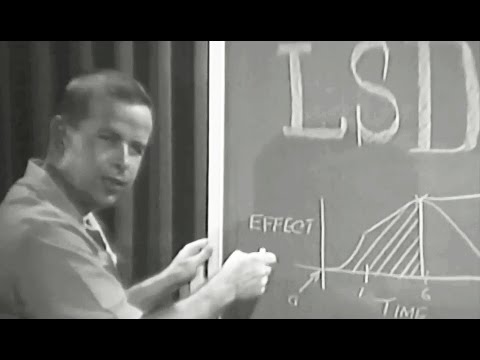LSD 1967 US Navy Training Film; Psychedelic Hallucinogen Lecture by Dr Walt Miner
more at
I don’t usually post talking head lectures, but this 1967 mix of facts, distortions and exaggerations [when you are high on LSD you ARE PSYCHOTIC] is more interesting than most, particularly when combined with the psychedelic intro/extro music and title page. It is, of course, understandable that the US Navy was not keen on having sailors on duty (e.g., conducting carrier deck ops) while tripping or hungover.
‘Navy physician talks about the dangers of LSD or “Russian roulette in a sugar cube…” “How LSD was discovered, the extreme dangers of using it and how it affects the brain and body.”‘
US Navy Training Film MN-10507-A
Public domain film from the US National Archives, slightly cropped to remove uneven edges, with the aspect ratio corrected, and mild video noise reduction applied.
The soundtrack was also processed with volume normalization, noise reduction, clipping reduction, and/or equalization (the resulting sound, though not perfect, is far less noisy than the original).
Lysergic acid diethylamide abbreviated LSD or LSD-25, also known as lysergide (INN) and colloquially as acid, is a psychedelic drug of the ergoline family, well known for its psychological effects, which can include altered thinking processes, closed- and open-eye visuals, synesthesia, an altered sense of time and spiritual experiences, as well as for its key role in 1960s counterculture. It is used mainly as an entheogen and recreational drug. LSD is non-addictive. However, acute adverse psychiatric reactions such as anxiety, paranoia, and delusions are possible.
LSD was first synthesized by Albert Hofmann in 1938 from ergotamine, a chemical derived by Arthur Stoll from ergot, a grain fungus that typically grows on rye. The short form “LSD” comes from its early code name LSD-25, which is an abbreviation for the German “Lysergsäure-diethylamid” followed by a sequential number. LSD is sensitive to oxygen, ultraviolet light, and chlorine, especially in solution, though its potency may last for years if it is stored away from light and moisture at low temperature. In pure form it is a colorless, odorless, tasteless solid. LSD is typically either swallowed (oral) or held under the tongue (sublingual), usually on a substrate such as absorbent blotter paper, a sugar cube, or gelatin… LSD is very potent, with 20–30 µg (micrograms) being the threshold dose.
Hofmann discovered the psychedelic properties of LSD in 1943. It was introduced commercially in 1947 by Sandoz Laboratories under the trade-name Delysid as a drug with various psychiatric uses. In the 1950s, officials at the U.S. Central Intelligence Agency (CIA) thought the drug might be applicable to mind control and chemical warfare; the agency’s MKULTRA research program propagated the drug among young servicemen and students. The subsequent recreational use of the drug by youth culture in the Western world during the 1960s led to a political firestorm that resulted in its prohibition…
LSD’s psychological effects (colloquially called a “trip”) vary greatly between persons and places. If the user is in a hostile or otherwise unsettling environment, or is not mentally prepared for the powerful distortions in perception and thought that the drug causes, effects are more likely to be unpleasant than if he or she is in a comfortable environment and has a relaxed, balanced and open mindset…
LSD causes an animated sensory experience of senses, emotions, memories, time, and awareness for 6 to 14 hours, depending on dosage and tolerance. Generally beginning within 30 to 90 minutes after ingestion, the user may experience anything from subtle changes in perception to overwhelming cognitive shifts. Changes in auditory and visual perception are typical…
A single dose of LSD may be between 40 and 500 micrograms—an amount roughly equal to one-tenth the mass of a grain of sand. Threshold effects can be felt with as little as 25 micrograms of LSD. Dosages of LSD are measured in micrograms (µg), or millionths of a gram. By comparison, dosages of most drugs, both recreational and medicinal, are measured in milligrams (mg), or thousandths of a gram. For example, an active dose of mescaline, roughly 0.2 to 0.5 g, has effects comparable to 100 µg or less of LSD.
In the mid-1960s, the most important black market LSD manufacturer (Owsley Stanley) distributed acid at a standard concentration of 270 µg, while street samples of the 1970s contained 30 to 300 µg. By the 1980s, the amount had reduced to between 100 and 125 µg, dropping more in the 1990s to the 20–80 µg range, and even more in the 2000s (decade)…

